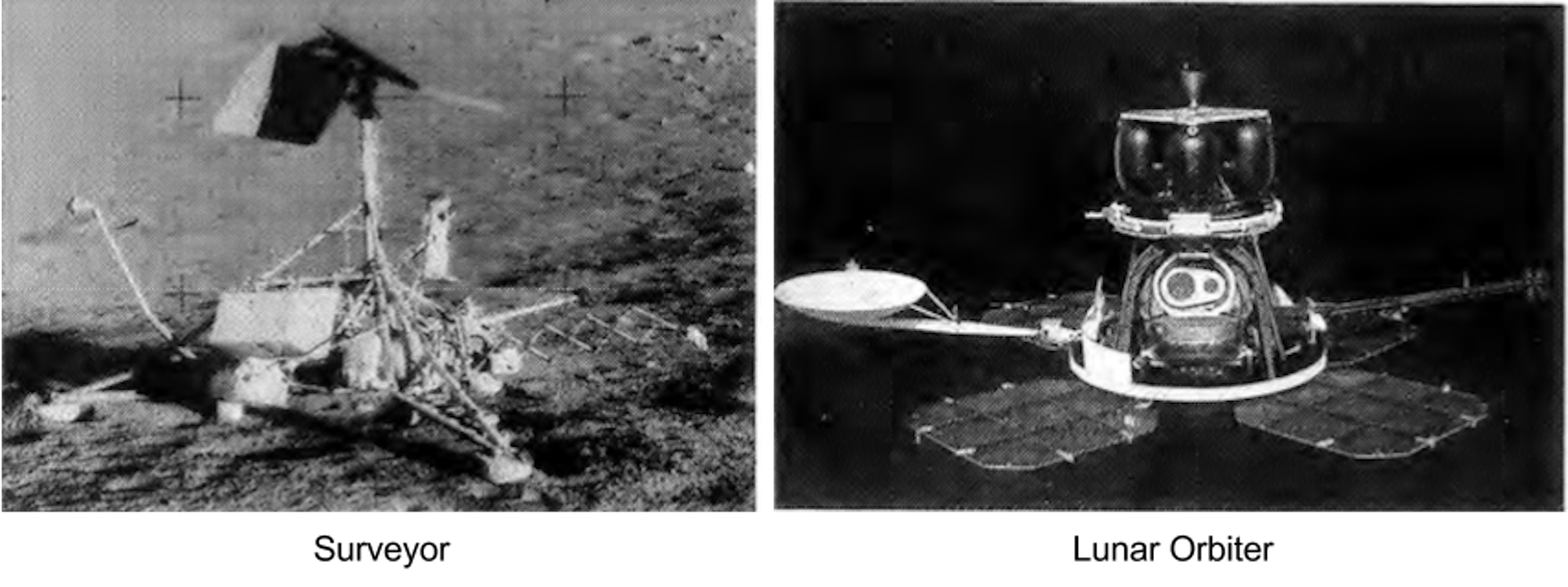I define project success as achieving the project goal. Once you really understand your goal, then success is achieved by leading your project team to follow a good plan. The better you lead your team, the faster and more efficiently you will reach the goal. The better your plan, the faster and more efficiently you will reach the goal. Reaching the goal completes the project. So, how do you judge your performance managing a project? That is, how do you know whether you reached the goal as fast and as efficiently as possible?
Given two successful projects (i.e. both projects achieved their goals), how can you judge which one was better managed? Maybe your projects are two complex American space missions carried out in the 1960s: Ambitious projects that sent unmanned spacecraft to study the Moon in advance of the Apollo program.
In 1972, NASA writer Erasmus Kloman compared project management on the Surveyor program and the Lunar Orbiter program. Both programs succeeded: They achieved all of their goals. Both were more expensive than planned. Yet the author consistently and strongly points to one program, Lunar Orbiter, as an example of successful project management while noting the early and persistent struggles that Surveyor only eventually overcame. One reason Kloman’s document is interesting is because NASA at the time was pushing forward the state of the art in many areas, not the least of which was project management.
Kloman states, “Surveyor and Lunar Orbiter rank as two of the outstanding accomplishments of NASA and the U.S. aerospace industry in preparing the way for Apollo. … The two projects were paired together for this analysis largely because of the many sharp contrasts in their two histories. … Whereas the Surveyor lessons include many illustrations of how “not to” set out on a project or how to correct for early misdirections, Lunar Orbiter shows how sound precepts and directions from the beginning can keep a project on track.”
How does Kloman’s judgement compare to program cost performance?
Kloman says, “NASA’s original estimated total cost of the Surveyor project was $125 million whereas the final costs came to $469 million, somewhat less than a fourfold increase. Lunar Orbiter costs were first estimated at $77 million and wound up at $163 million, or slightly more than a twofold increase.”
Before drawing any conclusions based on this cost performance data, let’s compare the cost growth to growth on other NASA projects of that era.
Kloman reports, “An analysis of 16 research and development projects being conducted by OSSA [Office of Space Science and Applications] during the sixties indicates that the average final costs were somewhat less than three and a half times the initial estimate”
So major cost growth was simply the norm at the time. The author warns against drawing any conclusions from cost performance due to a variety of factors. But we still want to assess project management performance so we can learn from mistakes and improve our performance on projects.
The author presents Lunar Orbiter as the better managed project. And the author tells us what made the difference: “…both the Surveyor and Lunar Orbiter experiences, from two very different angles, strongly underline the importance of human skills, interpersonal compatibility, and relationships based on mutual respect and confidence.”
Lunar Orbiter was fun to work on: “The positive attitude and enthusiasm of top management were contagious and infected the Lunar Orbiter project staffs.” Meanwhile, Surveyor was not considered a desirable program assignment, “The attitude of most JPL personnel toward a project assignment, particularly one based on contract monitoring, reflected a concern for any diversion from recognized paths of career advancement.”
The author summarizes, “What emerges perhaps most forcefully from a broad retrospective view is the importance of the human aspects of organization and management. Both projects demonstrated the critical nature of human skills, interpersonal relations, compatibility between individual managers, and teamwork.” This is a conclusion that should resonate with anyone who has ever worked anywhere.
The idea that the “human aspects” are critical to project success is the essence of what we call people-focused leadership. People-focused leadership is not new. It is timeless and it is true. That’s probably why people keep rediscovering it — like this author did in 1972.
Reference: "Unmanned Space Project Management, Surveyor and Lunar Orbiter" by Erasmus H. Kloman, National Aeronautics And Space Administration, Scientific and TechnicalInformation Office, 1972.
